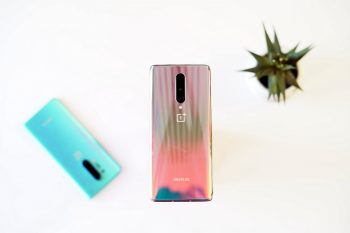
OnePlus 8 first look: the budget flagship smartphone we’ve been waiting for
Today, OnePlus unveiled its new flagship lineup for 2020, the OnepLus 8 and the 8 Pro. While many of you know that Oneplus released the 7 and 7 Pro last year, only the Pro was made available in the US. This time around, both phones are available, giving you the option to buy the cheaper phone if you’re not interested in all the bells and whistles that are included in the Pro.
Put simply, the OnePlus 8 is a barebones flagship smartphone, similar in many ways to the LG V60. It’s running a snapdragon 865 chipset with 8GB of RAM and 128GB of storage on the base model, but you can bump that up to 12GB of RAM and 256GB of storage if you’re willing to pay a bit more.
The phone’s 6.55-inch FHD+ OLED display isn’t massive, but it manages to deliver a refresh rate of 90FPS. The panel itself and the glass are curved, matching the glass panel on the back, giving the phone a smooth finish all the way around. To give the phone a bit of flare, the OnePlus 8 gets a unique Interstellar GLow finish on the back which is pretty similar to the Aura glow of the Samsung Galaxy Note 10. But it also comes in Onyx Black and Glacial Green. When looking at the phone from the back with its centrally placed camera bump, it’s almost indistinguishable from last year’s OnePlus 7 Pro.
For its triple camera setup, this phone features a 48MP main camera, 2MP macro camera and 16MP ultrawide. Unlike Samsung’s device, you won’t be getting 8K video capture here, but OnePlus is optimizing the 4k video capture mode with enhanced optical and electronic image stabilization which work simultaneously and a new Cine mode which features ultra-wide 21:9 video capture.
OnePlus 8 camera test: 65+ photos and videos
For its selfie camera, you get a 16Mp sensor which seems to capture decent shots, but video capture from it is limited to 1080p which is a shame since most other 2020 flagship smartphones we’ve seen have 4K video recording from their front-facing cameras.
On the software front- the OnePlus 8 is running Oxygen OS on top of Android 10. Things really haven’t changed much from last year, but this time around, you get the Google Feed to the left of the home screen, replacing the dashboard OnePlus has used in the past.
As always, the launcher is clean, intuitive and as quick as ever. While I’ve said this before, I need to iterate again how good the software experience is on Oneplus devices. The phone comes pre-installed with Netflix and a few apps from Facebook, but you’ll only find 37 apps in the app drawer including the 14 apps from Google which is a lot less than what you get on most other devices these days.
While the phone is likely just as fast and powerful as the 8 Pro, it’s missing the wireless charging, telephoto camera, official IP water resistance rating and a few other features that Oneplus has kept only for its larger counterpart.
As for pricing and availability of the OnePlus 8 are concerned, the phone will go on sale on April 29 for $699 for the base model and $799 for the 12GB variant.
If you want to see how the specs of these two phones stack up, make sure you check out our OnePlus 8 versus 8 Pro comparison.